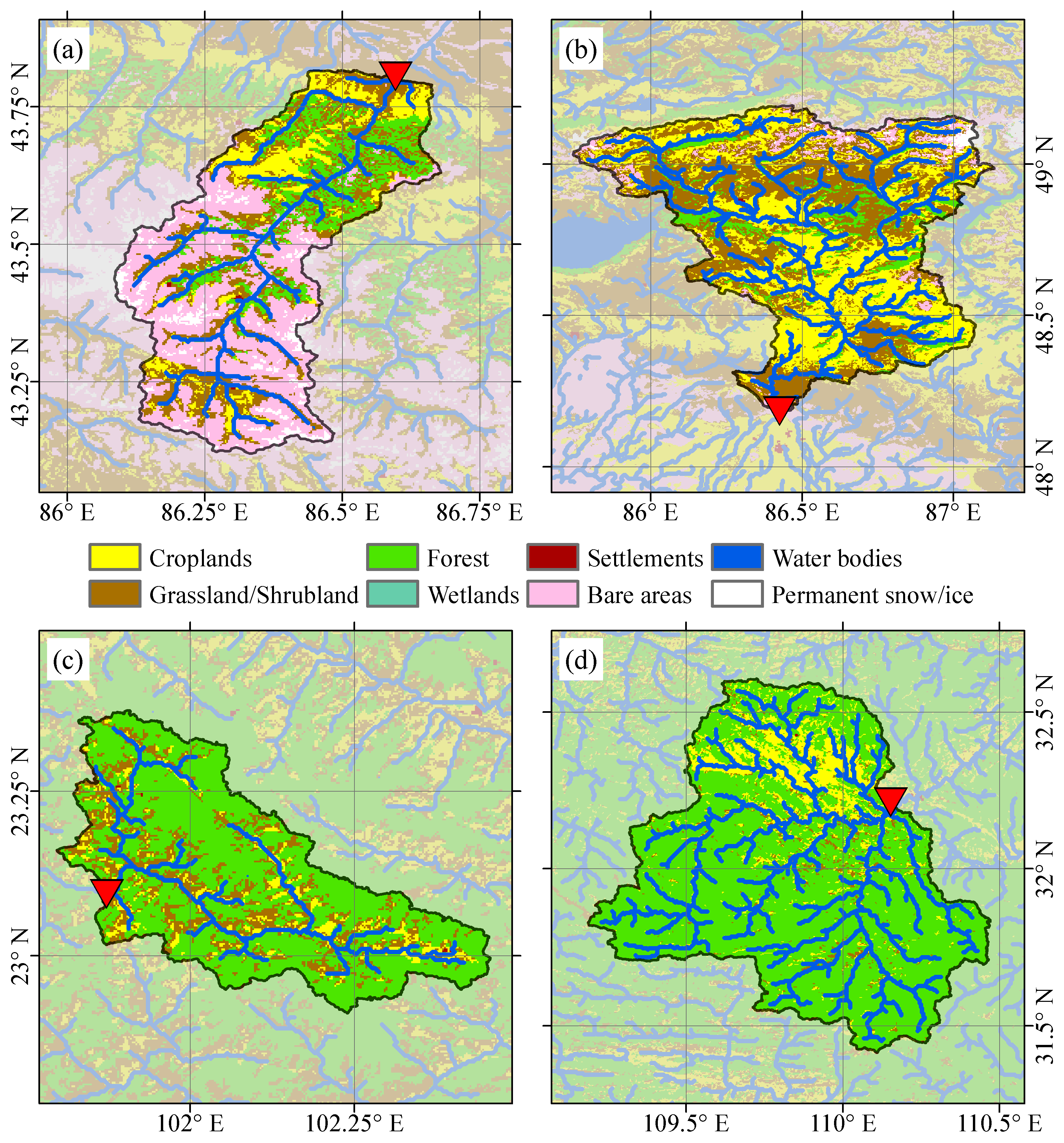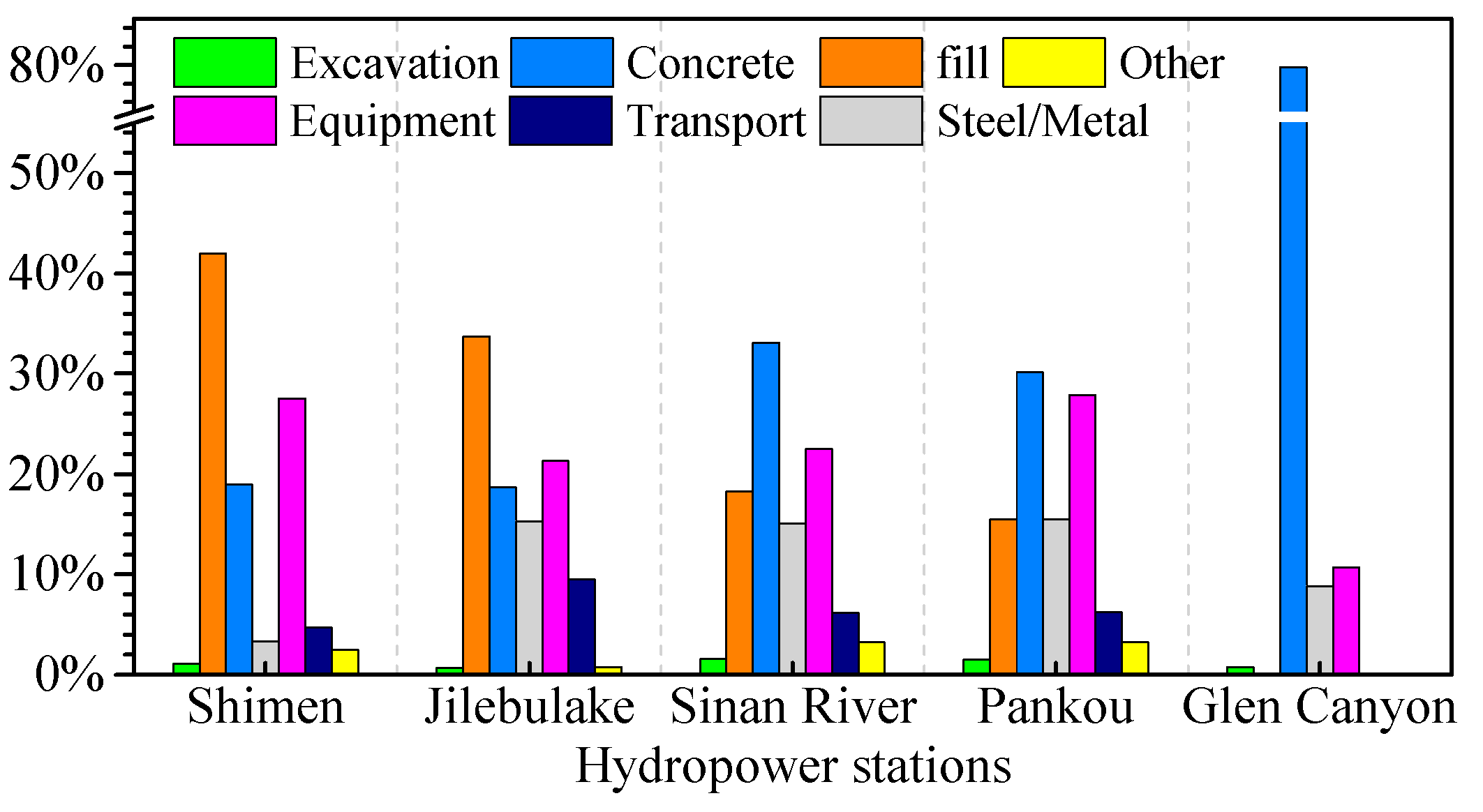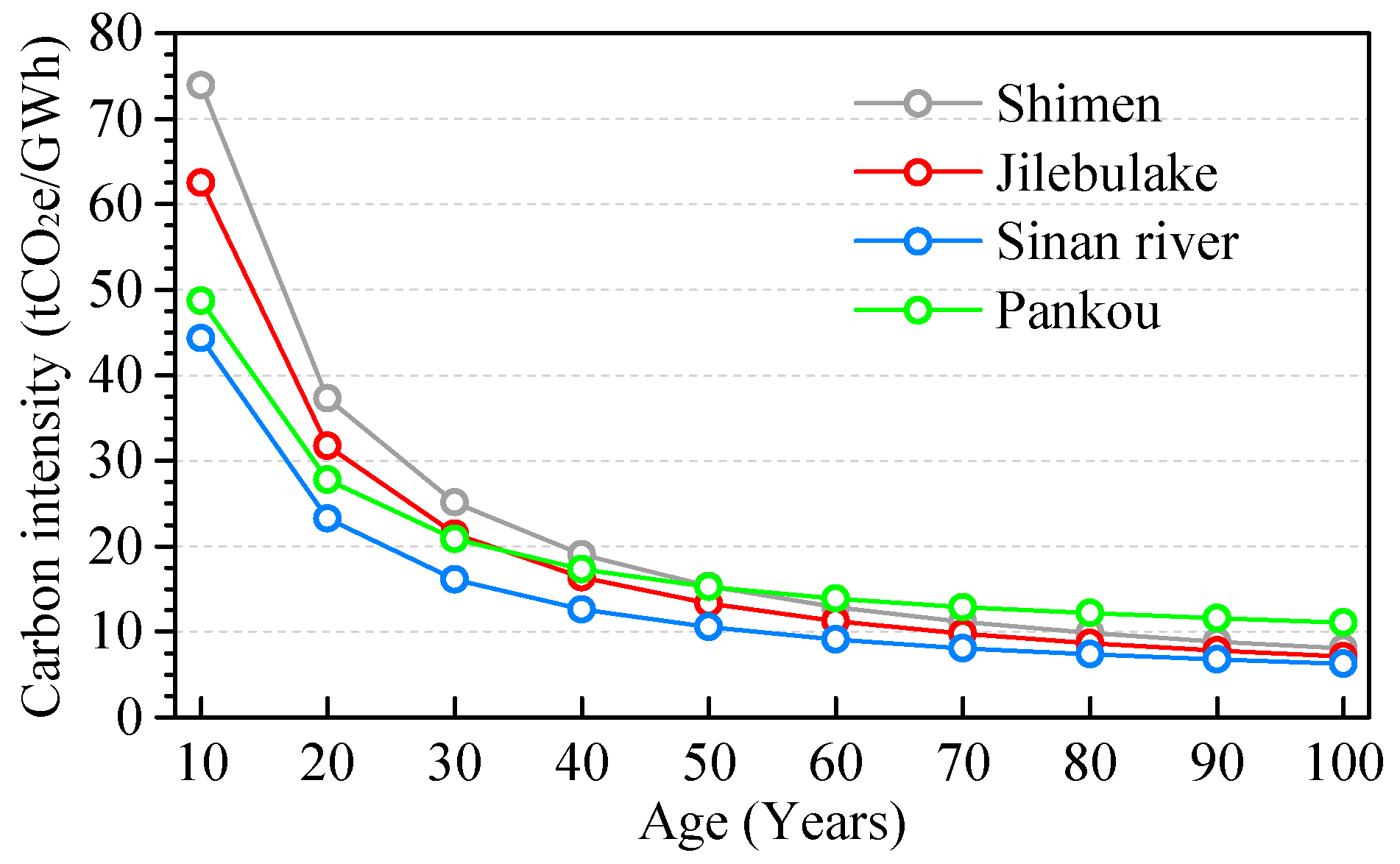Carbon Footprint Assessment of Four Normal Size Hydropower Stations in China
Abstract
:1. Introduction
2. Materials and Methods
2.1. GHG Reservoir (G-res) Tool
− [Pre-impoundment carbon balance of the reservoir area before reservoir introduction]
+ [Post-impoundment carbon balance of the reservoir]
− [Emissions from the reservoir due to unrelated anthropogenic sources (UAS)]
+ [GHG due to construction]
2.2. Study Sites and Data
3. Results and Discussion
3.1. Pre-Impoundment GHG Balance of the Reservoir Area before Its Introduction
3.2. Post-Impoundment GHG Balance of the Reservoir
3.3. Emissions from the Reservoir Due to UAS
3.4. GHG Due to Construction
3.5. Net GHG Footprint
3.6. Comparison and Discussion
4. Conclusions
Author Contributions
Funding
Acknowledgments
Conflicts of Interest
References
- IPCC. Climate Change 2013: The Physical Science Basis. Contribution of Working Group I to the Fifth Assessment Report of the Intergovernmental Panel on Climate Change; Cambridge University Press: Cambridge, UK; New York, NY, USA, 2014; pp. 659–740. ISBN 978-1-107-66182-0. [Google Scholar]
- Rogelj, J.; den Elzen, M.; Höhne, N.; Fransen, T.; Fekete, H.; Winkler, H.; Schaeffer, R.; Fu, S.; Riahi, K.; Meinshausen, M. Paris Agreement climate proposals need a boost to keep warming well below 2 °C. Nature 2016, 534, 631–639. [Google Scholar] [CrossRef] [PubMed] [Green Version]
- Rogelj, J.; Schaeffer, M.; Meinshausen, M.; Knutti, R.; Alcamo, J.; Riahi, K.; Hare, W. Zero emission targets as long-term global goals for climate protection. Environ. Res. Lett. 2015, 10, 105007. [Google Scholar] [CrossRef] [Green Version]
- Jackson, R.B.; Canadell, J.G.; Le Quéré, C.; Andrew, R.M.; Korsbakken, J.I.; Peters, G.P.; Nakicenovic, N. Reaching peak emissions. Nat. Clim. Chang. 2016, 6, 7–10. [Google Scholar] [CrossRef] [Green Version]
- Olivier, J.G.J.; Schure, K.M.; Peters, J.A.H.W. Trends in Global CO2 and Total Greenhouse Gas Emissions: 2017 Report; PBL Netherlands Environmental Assessment Agency: Hague, The Netherlands, 2017; pp. 8–12. [Google Scholar]
- IRENA. Renewable Energy Statistics 2017; The International Renewable Energy Agency: Abu Dhabi, UAE, 2017; pp. 8–34. ISBN 978-92-9260-0334. [Google Scholar]
- Statistical Review of World Energy, Energy Economics, BP. Available online: http://www.bp.com/en/global/corporate/energy-economics/statistical-review-of-world-energy.html (accessed on 17 February 2018).
- Pérez-Sánchez, M.; Sánchez-Romero, F.J.; Ramos, H.M.; López-Jiménez, P.A. Energy recovery in existing water networks: Towards greater sustainability. Water 2017, 9, 97. [Google Scholar] [CrossRef]
- Spänhoff, B. Current status and future prospects of hydropower in Saxony (Germany) compared to trends in Germany, the European Union and the World. Renew. Sust. Energy Rev. 2014, 30, 518–525. [Google Scholar] [CrossRef]
- Barros, N.; Cole, J.J.; Tranvik, L.J.; Prairie, Y.T.; Bastviken, D.; Huszar, V.L.M.; del Giorgio, P.; Roland, F. Carbon emission from hydroelectric reservoirs linked to reservoir age and latitude. Nat. Geosci. 2011, 4, 593–596. [Google Scholar] [CrossRef]
- Fearnside, P.M. Greenhouse gas emissions from hydroelectric dams: Controversies provide a springboard for rethinking a supposedly ‘clean’ energy source. An editorial comment. Clim. Chang. 2004, 66, 1–8. [Google Scholar] [CrossRef]
- Paish, O. Micro-hydropower: Status and prospects. Proc. Inst. Mech. Eng. Part A J. Power Energy 2002, 216, 31–40. [Google Scholar] [CrossRef]
- Wiedmann, T.; Minx, J. The Definition of a Carbon Footprint. In Ecological Economics Research Trends; Pertsova, C.C., Ed.; Nova Science Publishers: New York, NY, USA, 2008; pp. 1–11. ISBN 1-60021-941-1. [Google Scholar]
- Pandey, D.; Agrawal, M.; Pandey, J.S. Carbon footprint: Current methods of estimation. Environ. Monit. Assess. 2011, 178, 135–160. [Google Scholar] [CrossRef] [PubMed]
- Gallagher, J.; Styles, D.; McNabola, A.; Williams, A.P. Current and future environmental balance of small-scale run-of-river hydropower. Environ. Sci. Technol. 2015, 49, 6344–6351. [Google Scholar] [CrossRef] [PubMed]
- Gallagher, J.; Styles, D.; McNabola, A.; Williams, A.P. Life cycle environmental balance and greenhouse gas mitigation potential of micro-hydropower energy recovery in the water industry. J. Clean Prod. 2015, 99, 152–159. [Google Scholar] [CrossRef]
- Varun, I.K.; Prakash, B.R. LCA of renewable energy for electricity generation systems—A review. Renew. Sust. Energy Rev. 2009, 13, 1067–1073. [Google Scholar] [CrossRef]
- Prakash, R.; Bhat, I.K. Life cycle greenhouse gas emissions estimation for small hydropower schemes in India. Energy 2012, 44, 498–508. [Google Scholar] [CrossRef]
- Suwanit, W.; Gheewala, S.H. Life cycle assessment of mini-hydropower plants in Thailand. Int. J. LCA 2011, 16, 849–858. [Google Scholar] [CrossRef]
- García-Gusano, D.; Iribarren, D.; Martín-Gamboa, M.; Dufour, J.; Espegren, K.; Lind, A. Integration of life-cycle indicators into energy optimisation models: The case study of power generation in Norway. J. Clean Prod. 2016, 112, 2693–2696. [Google Scholar] [CrossRef]
- Valente, A.; Iribarren, D.; Dufour, J.; Spazzafumo, G. Life-cycle performance of hydrogen as an energy management solution in hydropower plants: A case study in Central Italy. Int. J. Hydrogen Energy 2015, 40, 16660–16672. [Google Scholar] [CrossRef]
- Ribeiro, F.d.M.; da Silva, G.A. Life-cycle inventory for hydroelectric generation: A Brazilian case study. J. Clean Prod. 2010, 18, 44–54. [Google Scholar] [CrossRef]
- Liu, Y.; Wang, F.; Zheng, J.Y. Estimation of greenhouse gas emissions from the EU, US, China, and India up to 2060 in comparison with their pledges under the Paris agreement. Sustainability 2017, 9, 1587. [Google Scholar] [CrossRef]
- Mi, Z.F.; Meng, J.; Guan, D.B.; Shan, Y.L.; Liu, Z.; Wang, Y.T.; Feng, K.; Wei, Y.-M. Pattern changes in determinants of Chinese emissions. Environ. Res. Lett. 2017, 12, 074003. [Google Scholar] [CrossRef] [Green Version]
- Mi, Z.F.; Meng, J.; Guan, D.B.; Shan, Y.L.; Song, M.L.; Wei, Y.M.; Liu, Z.; Hubacek, K. Chinese CO2 emission flows have reversed since the global financial crisis. Nat. Commun. 2017, 8, 1712. [Google Scholar] [CrossRef] [PubMed]
- Du, H.L.; Li, Z.; Guo, J.S. Carbon footprint of a large hydropower project in the upstream of the Yangtze: Following ISO14067. Resour. Environ. Yangtze Basin 2017, 26, 1102–1110. (In Chinese) [Google Scholar] [CrossRef]
- Li, Z.; Du, H.L.; Xiao, Y.; Guo, J.S. Carbon footprints of two large hydro-projects in China: Life-cycle assessment according to ISO/TS 14067. Renew. Energy 2017, 114, 534–546. [Google Scholar] [CrossRef]
- Zhang, Q.F.; Karney, B.; MacLean, H.L.; Feng, J.C. Life-cycle inventory of energy use and greenhouse gas emissions for two hydropower projects in China. J. Infrastruct. Syst. 2007, 13, 271–279. [Google Scholar] [CrossRef]
- Zhang, S.R.; Pang, B.H.; Zhang, Z.L. Carbon footprint analysis of two different types of hydropower schemes: Comparing earth-rockfill dams and concrete gravity dams using hybrid life cycle assessment. J Clean Prod. 2015, 103, 854–862. [Google Scholar] [CrossRef]
- Ministry of Water Resources China; National Bureau of Statistics China. Bulletin of First National Census for Water; China Water & Power Press: Beijing, China, 2011; pp. 3–7. ISBN 9787517007173.
- Prairie, Y.T.; Alm, J.; Harby, A.; Mercier-Blais, S.; Nahas, R. The GHG Reservoir Tool (G-res), UNESCO/IHA Research Project on the GHG Status of Freshwater Reservoirs. Version 1.1. Available online: http://www.hydropower.org/gres-tool (accessed on 17 March 2018).
- Prairie, Y.T.; Alm, J.; Beaulieu, J.; Barros, N.; Battin, T.; Cole, J.; del Giorgio, P.; DelSontro, T.; Guérin, F.; Harby, A.; et al. Greenhouse gas emissions from freshwater reservoirs: What does the atmosphere see? Ecosystems 2017, 1–14. [Google Scholar] [CrossRef]
- IPCC. IPCC Special Report on Renewable Energy Sources and Climate Change Mitigation. Prepared by Working Group III of the Intergovernmental Panel on Climate Change; Cambridge University Press: Cambridge, UK; New York, NY, USA, 2011; pp. 80–87. ISBN 978-92-9169-131-9. [Google Scholar]
- Prairie, Y.T.; Alm, J.; Harby, A.; Mercier-Blais, S.; Nahas, R. The GHG Reservoir Tool (G-res) User Guide, UNESCO/IHA Research Project on the GHG Status of Freshwater Reservoirs; Version 1.1; Joint publication of the UNESCO Chair in Global Environmental Change and the International Hydropower Association: London, UK, 2017; pp. 1–38. [Google Scholar]
- Farr, T.G.; Rosen, P.A.; Caro, E.; Crippen, R.; Duren, R.; Hensley, S.; Kobrick, M.; Paller, M.; Rodriquez, E.; Roth, L.; et al. The shuttle radar topography mission. Rev. Geophys. 2007, 45, RG2004. [Google Scholar] [CrossRef]
- Prairie, Y.T.; Alm, J.; Harby, A.; Mercier-Blais, S.; Nahas, R. User Guidelines for the Earth Engine Functionality, UNESCO/IHA Research Project on the GHG Status of Freshwater Reservoirs; Joint publication of the UNESCO Chair in Global Environmental Change and the International Hydropower Association: London, UK, 2017; pp. 1–24. [Google Scholar]
- Three Global LC Maps for the 2000, 2005 and 2010 Epochs. Available online: http://www.esa-landcover-cci.org/?q=node/158 (accessed on 17 February 2018).
- Prairie, Y.T.; Alm, J.; Harby, A.; Mercier-Blais, S.; Nahas, R. The GHG Reservoir Tool (G-res) Technical Documentation, UNESCO/IHA Research Project on the GHG Status of Freshwater Reservoirs; Version 1.1; Joint publication of the UNESCO Chair in Global Environmental Change and the International Hydropower Association: London, UK, 2017; pp. 1–76. [Google Scholar]
- Zheng, J.Y.; Yin, Y.H.; Li, B.Y. A new scheme for climate regionalization in China. Acta Geograph. Sin. 2010, 65, 3–13. (In Chinese) [Google Scholar]
- Patterson, T.; Jenny, B. The development and rationale of cross-blended hypsometric tints. Cartogr. Perspect. 2011, 69, 31–46. [Google Scholar] [CrossRef]
- Qu, M.Q. The Construction Organization Design of Shimen Hydropower Station Engineering. Master’s Thesis, Xi’an University of Technology, Xi’an, Shaanxi Province, China, 2011. (In Chinese). [Google Scholar]
- Wang, H.Q.; Li, X.L. Analysis of turbine type selection and design in Shimen hydropower station. Shaanxi Water Resour. 2017, 5, 141–143. (In Chinese) [Google Scholar] [CrossRef]
- Han, Z.F.; He, W.C.; Gao, W. Construction Technology for Concrete Faced Rockfill Dam of Jilebulake Hydropower Station in Xinjiang. In Technical Progress of Concrete Faced Rockfill Dam in High and Cold Region; China Society for Hydropower Engineering, Sinohydro Bureau 11 CO., LTD., Ed.; China Water and Power Press: Beijing, China, 2013; pp. 42–50. ISBN 978-7-5170-1225-2. (In Chinese) [Google Scholar]
- Liu, S.W.; (Southeast University, Nanjing, Jiangsu Province, China). Construction planning document for Jilebulake hydropower station. Personal communication, 2014. (In Chinese). [Google Scholar]
- Shen, Z.Z.; Nie, B.S.; Sun, Y.F.; (Hohai University, Nanjing, Jiangsu Province, China). Construction planning document for Sinan River hydropower station. Personal communication, 2014. (In Chinese). [Google Scholar]
- Hu, W.; Hu, J. Overview on engineering design of Pankou hydropower station. Yangtze River 2012, 43, 26–30. (In Chinese) [Google Scholar] [CrossRef]
- Hu, W.N.; Zhou, Q.D.; Zhang, H.N. Structural characteristics of turbines, Pankou hydropower station. Northwest. Hydropower 2012, S1, 51–54. (In Chinese) [Google Scholar] [CrossRef]
- Liu, S.W.; (Southeast University, Nanjing, Jiangsu Province, China). Construction planning document for Pankou hydropower station. Personal communication, 2014. (In Chinese). [Google Scholar]
- Sentinels Scientific Data Hub. Available online: https://scihub.copernicus.eu/dhus (accessed on 10 March 2018).
- Chang, K.T. Introduction to Geographic Information System, 7th ed.; McGraw-Hill Education: New York, NY, USA, 2014; pp. 293–315. ISBN 978-0-07-352290-6. [Google Scholar]
- Pacca, S.; Horvath, A. Greenhouse gas emissions from building and operating electric power plants in the Upper Colorado River Basin. Environ. Sci. Technol. 2002, 36, 3194–3200. [Google Scholar] [CrossRef] [PubMed]
- China’s National Energy Administration. Available online: http://www.nea.gov.cn/2017-09/25/c_136636915.htm (accessed on 17 February 2018).





| Hydropower Stations | Shimen | Jilebulake | Sinan River | Pankou |
|---|---|---|---|---|
| Temperature (°C) | 6.25 | 4.11 | 21.04 | 15.80 |
| Precipitation (mm) | 409.1 | 175.1 | 1710 | 882.7 |
| Runoff (m3/s) | 14.4 | 68.8 | 43.4 | 164 |
| Wind speed at 10 m above surface (m/s) | 4.71 | 4.74 | 2.31 | 2.72 |
| Surface horizontal radiance (kWh/m2/day) | 4.09 | 3.92 | 4.61 | 3.61 |
| Soil carbon content (kgC/m2) | 0 | 2.16 | 5.97 | 2.42 |
| Hydropower Stations | Shimen | Jilebulake | Sinan River | Pankou |
|---|---|---|---|---|
| Impoundment year | 2013 | 2013 | 2007 | 2011 |
| Normal operating level (m a.s.l.) | 1240 | 752 | 900 | 355 |
| Water intake elevation (m a.s.l.) | 1175 | 698 | 850 | 309 |
| Maximum dam height (m) | 106 | 146.4 | 115 | 114 |
| Top length of the dam (m) | 312.51 | 464 | 344.46 | 292 |
| Catchment area (km2) | 1881 | 6056 | 1583 | 8950 |
| Total reservoir volume (km3) | 0.0775 | 0.232 | 0.247 | 2.353 |
| Regulated storage capacity (km3) | 0.0702 | 0.143 | 0.202 | 1.120 |
| Turbine type | HLA936-LJ-186 | HL166-LJ-190 HL166-LJ-242 | HLF-LJ-230 | HL-LJ-611.2 |
| Net head (m) | 211 | 110 | 320 | 83 |
| Flow rate (m3/s) | 25.08 | 30.95/51.47 | 23.6 | 337.85 |
| Efficiency (%) | 93.94 | 85 | - | 92.83 |
| Installed capacity (MW) | 95 | 160 | 201 | 500 |
| Availability factor (hours/year) | 2253 | 2700/3400 | 4575 | 2157 |
| Total annual generation (GWh/year) | 214 | 495 | 908 | 1079 |
| Investments (104 CNY) | 138,400 | 129,754.34 | 139,852.49 | 439,700 |
| Open excavation (m3) | 1,248,642 | 1,179,900 | 1,825,560 | 4,186,400 |
| Underground excavation (m3) | 819 | 87,100 | 607,100 | 179,300 |
| Earth and rockfill (m3) | 3,057,871 | 4,942,400 | 2,973,000 | 3,349,600 |
| Concrete (m3) | 88,379 | 170,200 | 379,000 | 405,000 |
| Steel and other metal structures (t) | 1904 | 18468 | 22400 | 27545 |
| Hydropower Stations | Shimen | Jilebulake | Sinan River | Pankou |
|---|---|---|---|---|
| Longitude (°E) | 86.597 | 86.426 | 101.873 | 110.153 |
| Latitude (°N) | 43.805 | 48.183 | 23.094 | 32.212 |
| Catchment area (km2) | 1922 | 6081 | 1594 | 8927 |
| Catchment area error (%) | 2.18 | 0.41 | 0.69 | 0.26 |
| Reservoir volume (km3) | 0.0690 | 0.237 | 0.257 | 2.389 |
| Reservoir volume error (%) | 1.59 | 2.08 | 4.14 | 1.55 |
| Hydropower Stations | Shimen | Jilebulake | Sinan River | Pankou |
|---|---|---|---|---|
| Bare areas (%) | 14.71 | 70.59 | 0 | 0 |
| Grassland/shrubland (%) | 85.29 | 1.47 | 60.19 * | 24.00 |
| Water bodies (%) | 0 | 27.94 | 0 | 0 |
| Croplands (%) | 0 | 0 | 3.88 | 55.71 |
| Forest (%) | 0 | 0 | 35.92 | 19.26 |
| Settlements (%) | 0 | 0 | 0 | 1.03 |
| Areal CO2 emission rate (gCO2e/m2/year) | 0 | 0 | −50 | −17 |
| Areal CH4 emission rate (gCO2e/m2/year) | 0 | 10 | 0 | 0 |
| Hydropower Stations | Shimen | Jilebulake | Sinan River | Pankou |
|---|---|---|---|---|
| CO2 release rate (gCO2e/m2/year) | 49 (22–113) | 43 (19–99) | 144 (63–331) | 98 (43–225) |
| CH4 release rate (gCO2e/m2/year) | 35.2 (9.9–125.0) | 39.4 (11.1–139.9) | 223.7 (63.0–794.1) | 72.0 (20.3–255.6) |
| - in which diffusive flux (%) | 79 | 78 | 40 | 62 |
| - in which degassing (%) | 16 | 17 | 36 | 29 |
| - in which bubbling (%) | 5 | 5 | 24 | 9 |
| Hydropower Stations | Shimen | Jilebulake | Sinan River | Pankou |
|---|---|---|---|---|
| Water residence time (year) | 11.1 | 9.4 | 0.3 | 0.8 |
| CH4 release rate due to UAS (gCO2e/m2/year) | 15.0 | 15.5 | 188.6 | 65.4 |
| - in which from land use (%) | 17 | 57 | 4 | 3 |
| - in which from sewage (%) | 83 | 43 | 96 | 97 |
| UAS/Post-impoundment CH4 release (%) | 43 | 39 | 84 | 91 |
| Hydropower Stations | Shimen | Jilebulake | Sinan River | Pankou |
|---|---|---|---|---|
| Pre-impoundment (tCO2e/year) | 0 | 84 | −411 | −1057 |
| Post-impoundment (tCO2e/year) | 185 | 674 | 2999 | 10397 |
| UAS (tCO2e/year) | 33 | 126 | 1540 | 3991 |
| Construction (tCO2e) | 156,563 | 304,880 | 384,074 | 450,436 |
| Hydropower Stations | Baihetan | Xiluodu | Xiangjiaba | Nuozhadu | Jinpingyiji |
|---|---|---|---|---|---|
| Longitude (°E) | 102.9 | 103.62 | 104.39 | 100.42 | 101.63 |
| Latitude (°N) | 27.2 | 28.24 | 28.64 | 22.65 | 28.18 |
| Installed capacity (MW) | 16,000 | 12,600 | 6400 | 5850 | 3600 |
| Total carbon footprint (tCO2e) | 54,169,000 | 40,817,202 | 24,213,563 | 11,692,500 | 9,539,000 |
| Total annual generation (GWh/year) | 62,520 | 60,590 | 30,880 | 23,912 | 16,620 |
| Designed lifetime (year) | 100 | 100 | 100 | 44 | 100 |
| Carbon intensity (tCO2e/GWh) | 8.66 | 6.74 | 7.84 | 11.11 | 5.74 |
© 2018 by the authors. Licensee MDPI, Basel, Switzerland. This article is an open access article distributed under the terms and conditions of the Creative Commons Attribution (CC BY) license (http://creativecommons.org/licenses/by/4.0/).
Share and Cite
Jiang, T.; Shen, Z.; Liu, Y.; Hou, Y. Carbon Footprint Assessment of Four Normal Size Hydropower Stations in China. Sustainability 2018, 10, 2018. https://doi.org/10.3390/su10062018
Jiang T, Shen Z, Liu Y, Hou Y. Carbon Footprint Assessment of Four Normal Size Hydropower Stations in China. Sustainability. 2018; 10(6):2018. https://doi.org/10.3390/su10062018
Chicago/Turabian StyleJiang, Ting, Zhenzhong Shen, Yang Liu, and Yiyang Hou. 2018. "Carbon Footprint Assessment of Four Normal Size Hydropower Stations in China" Sustainability 10, no. 6: 2018. https://doi.org/10.3390/su10062018





